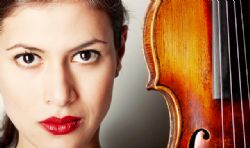|
Symphony
FROM THE NEW WORLD TO THE OLD WORLD
by Peter Lert
Saturday, June 14, 2025
Chamber
MC2 DUO RECITAL CLOSES 222'S SEASON
by Terry McNeill
Saturday, June 14, 2025
Choral and Vocal
CANTIAMO SONOMA'S LUSCIOUS A CAPELLA SINGING IN SEASON ENDING CONCERT
by Pamela Hicks Gailey
Sunday, June 8, 2025
Symphony
SRS SEASON ENDS WITH RESOUNDING TA-TA-TA-BANG
by Terry McNeill
Sunday, June 1, 2025
Symphony
YOUTHFUL VIRTUOSITY ON DISPLAY AT USO'S MAY CONCERTS
by Peter Lert
Saturday, May 17, 2025
Symphony
MYSTICAL PLANETS AND LIVELY GERSHWIN ORTIZ AT FINAL SRS CONCERT
by Peter Lert
Sunday, May 4, 2025
Symphony
VSO'S CONCERT MUSIC OF TIME, MUSIC OF PLACE
by Peter Lert
Sunday, April 27, 2025
VOCAL ELEGANCE AND FIRE AT THE 222'S RECITAL APRIL 26
by Pamela Hicks Gailey
Saturday, April 26, 2025
CANTIAMO SONOMA SINGS AN INSPIRED GOOD FRIDAY MOZART REQUIEM CONCERT
by Pamela Hicks Gailey
Friday, April 18, 2025
DRAMATIC SHOSTAKOVICH SYMPHONY CLOSES PHILHARMONIC'S 25TH SEASON
by Terry McNeill
Sunday, April 13, 2025
|
 |
 Violinist Elena Urioste |
AMERICAN CLASSICS SPARKLE UNDER KAHANE’S BATON
by Steve Osborn
Saturday, March 16, 2019
Jeffrey Kahane, the Santa Rosa Symphony’s former conductor, returned to the Weill Hall podium on Saturday night, and the results were expectedly wonderful. The concert of American classics was by turns playful (Gershwin’s “An American in Paris”), emotional (Barber’s violin concerto) and triumphant (Copland’s third symphony). The players were in top form, and the soloist, Elena Urioste, was a marvel to behold. The only flaws were in the music itself, not in the performance.
Before raising his baton for the Gershwin, Mr. Kahane explained that “An American in Paris” was heavily edited for the movie version, which is the same version that audiences have heard for the past 70 years. That’s beginning to change because of a revised edition published in 2017 that restores Gershwin’s original score, including dissonant taxi horns and a trio for soprano saxophones. The original score proved far more intriguing than its Hollywooden imitation. The orchestration is more inventive, the dissonances more pronounced, and the orchestral timbre more expansive, thanks in large part to the plethora of saxophones (six in all) and a bristling arsenal of percussion instruments.
Mr. Kahane set a brisk tempo, coaxing light and transparent playing from his colleagues, along with considerable rhythmic flexibility. Both of his arms were in constant movement, but he steered clear of dramatic gestures, preferring a subtler approach. The violin, trumpet and trombone solos were excellent, backed by the orchestra’s lush and confident sound. The “new” soprano sax trio was startling, made all the more memorable by the players’ donning of dark glasses.
What impressed most during the performance was the variety of musical material and the intricacy of the orchestration. The contrast between the languid and the energetic was profound, and the buildup to the clamorous ending, beginning with a wonderful tuba solo, was palpably exciting. Raucous applause and an immediate standing ovation followed.
The mood changed considerably when soloist Elena Urioste appeared on stage in a garish red pantsuit, inhabiting an opposite sartorial universe from the black-clad musicians. The distraction of the Ms. Urioste’s outfit faded as soon as she began to play the Barber violin concerto, but she still remained apart from her fellow musicians. She began the concerto somewhat timidly, barely projecting above the orchestra. Her warm tone and flawless technique didn’t become evident until well into the opening movement. She shone brightly in the solo passages, but the balance problems persisted, particularly when she was drowned out by the French horns in an otherwise beautiful passage.
The slow second movement proved to be Ms. Urioste’s salvation. She entered with a beguiling pianissimo, followed by a dramatic crescendo. Her vibrato was warm and convincing, and her tone, particularly on the lower strings, was sumptuous. She sustained the intensity through seamless bowing and a sincere expression of feeling.
Ms. Urioste displayed a different kind of intensity in the presto third movement, marked “in moto perpetuo” (in perpetual movement). She tore out of the gate at breakneck speed, and her arms and fingers were a blur for the next few minutes until she crossed the finish line with an even faster burst of energy. Most if not all of the notes were one per bow, so the speed source was primarily her bowing arm, which whipped back and forth incessantly, a flexible combination of shoulder, elbow and wrist. The result was dazzling.
The fourth movement of Copland’s third symphony reprises the composer’s well-known “Fanfare for the Common Man,” but the others are original, and all are marked by Copland’s distinctive open sound. In contrast to “Appalachian Spring,” “Billy the Kid” and Copland’s other program music, the third symphony is classically formal and mostly devoid of exterior references. Structure is paramount and inescapable. Certain devices--such as wide melodic intervals, syncopation and fugal entries--are used throughout.
The reliance on form animates the first and second movements, but it becomes oppressive by the third, where one begins to long for a little relief. Despite the formal constrictions, the performance itself was sparkling. Mr. Kahane conducted without a baton and used both hands equally to corral the relentless energy and give each orchestral section its due. The second movement was notable for its militaristic march, punctuated by occasional percussive gunshots.
The prime dynamic for all four movements was fortissimo, especially the fourth movement. The most telling image of the night came in that movement, when a momentarily tacit trumpeter covered his ears firmly during the first brass fanfare. Moments later, he threw caution to the winds and joined the piercing blast.
The skillful playing of the entire ensemble continued unabated through some astoundingly intricate passages, and the concluding brass fanfare ensured a memorable close. The performance was a tour de force, but the music could have used some of Gershwin’s flexibility or Barber’s emotion.
Reprinted by permission from San Francisco Classical Voice.
|
